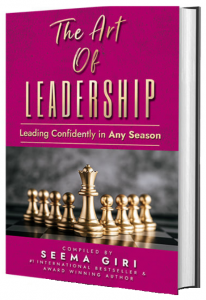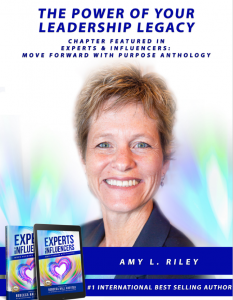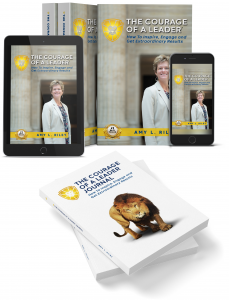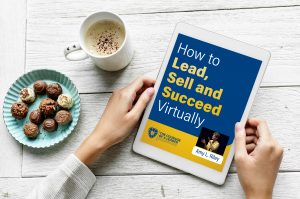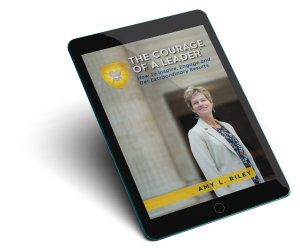My guest today on The Courage of a Leader podcast is Heather Dean. We delved into the importance of fostering creative risk-taking among leaders to address complex problems and seize opportunities in various industries.
In this episode, Heather discusses three main leadership approaches represented by different light sources: flashlight, chandelier, and strobe light.
This is not an episode to miss!
About the Guest:
Heather Dean has been designing learning experiences for over 25 years. She supports professionals in a wide variety of fields to design engaging meaningful experiences for their clients, customers, students, or teams. The end goal is to build understanding, to get the Lightbulbs to Turn On!
Whether they wish to reform complex problems, broaden perspectives, build a more meaningful life, lift communities, or achieve economic and academic success, she is here to help. No matter the audience, the setting, or the topic – from formal classrooms to corporate meetings to social change initiatives – interactions can be improved for better outcomes.
Heather has a BA in Studio Art/Art History from Denison University, a Master’s in Education from DePaul University and holds her National Board Professional Teaching Certificate. She currently works from and lives in Madison, WI.
The best way to reach Heather is through her website, https://creativeacrossthecurriculum.com/ and this contact number 773.680.7987.
About the Host:
Amy L. Riley is an internationally renowned speaker, author and consultant. She has over 2 decades of experience developing leaders at all levels. Her clients include Cisco Systems, Deloitte and Barclays.
As a trusted leadership coach and consultant, Amy has worked with hundreds of leaders one-on-one, and thousands more as part of a group, to fully step into their leadership, create amazing teams and achieve extraordinary results.
Amy’s most popular keynote speeches are:
- The Courage of a Leader: The Power of a Leadership Legacy
- The Courage of a Leader: Create a Competitive Advantage with Sustainable, Results-Producing Cross-System Collaboration
- The Courage of a Leader: Accelerate Trust with Your Team, Customers and Community
- The Courage of a Leader: How to Build a Happy and Successful Hybrid Team
Her new book is a #1 international best-seller and is entitled, The Courage of a Leader: How to Inspire, Engage and Get Extraordinary Results.
https://www.linkedin.com/in/amyshoopriley/
Link mentioned in the podcast
The Inspire Your Team assessment (the courage assessment): https://courageofaleader.com/inspireyourteam/
The Courage of a Leader, How To Inspire, Engage and Get Extraordinary Results (book): https://courageofaleader.com/the-courage-of-a-leader-book/
Thanks for listening!
Thanks so much for listening to The Courage of a Leader podcast! If you got inspired and/or got valuable leadership techniques you can use from this episode and think that others could benefit from listening, please share using the social media buttons on this page.
Do you have questions or feedback about this episode? Leave a comment in the section below!
Subscribe to the podcast
If you would like to get automatic updates of new The Courage of a Leader podcast episodes, you can subscribe to the podcast on Apple Podcasts. You can also subscribe in your favorite podcast app.
Leave us an Apple Podcasts review
Ratings and reviews from our listeners are extremely valuable to us and greatly appreciated. They help our podcast rank higher on Apple Podcasts, which helps us ignite The Courage of a Leader in more leaders! Please take a minute and leave an honest review on Apple Podcasts.
Teaser for next episode
Stay tuned for our next guest podcast episode – How the Famed Exec Club Overcame COVID Crossroads to Ultimately Thrive – with Margaret Meuller, Board Director, and the President and CEO of The Executives’ Club of Chicago.
Transcript
My guest today is Heather Dean, the founder of Creative Across the Curriculum. Heather shares with us in a very accessible way about light bulb leadership, and how you can foster creative risk and full engagement in your teens.
Amy Riley:Welcome to the Courage of a Leader podcast. This is where you hear real life stories of top leaders achieving extraordinary results. And you get practical advice and techniques, you can immediately apply for your own success. This is where you will get inspired. And take bold, courageous action. I am so glad you can join us. I'm your host, Amy Riley. Now, are you ready to step into the full power of your leadership and achieve the results you care about most? Let's ignite the Courage of a Leader.
Amy Riley:Heather, thank you for being here today on the Courage of a Leader podcast.
Heather Dean:Thanks for having me. Good morning.
Amy Riley:Yeah, I'm excited to have this discussion. So to set the context, there are significant disruptions occurring in every industry right now we have complex problems, we have interesting opportunities right now. So you and I are going to talk about creative risk, and how leaders can foster that. And you have an interesting and illuminating metaphor for this. Heather, will you tell us about light bulb leadership?
Heather Dean:Thanks again for having me. Just a pleasure. And you're right that the way that the world is working, we can't miss these creative opportunities, these creative risks that we need for all across the spectrum all across the continuum all across the world, we need people leaning into those opportunities. So I call this work light bulb leadership. And that's basically leaders using a lens to make sure they're designing experiences in our actions that are going to build understanding that are going to engage with others, and then ask for the creative contribution. So less on the leadership brain, more on the follower brain to say, what do you see? What do you notice? What What can you contribute? What is there? What is the outlier idea that nobody's thought of yet, it could be the exact solution that that the problem needs in order to move and make progress. It does take energy light bulb leadership does, you're not going to get light bulbs to turn on for the people you're leading. If you don't have the energy to be aware, and then to acknowledge and then to go and attend the audience, make sure that their light bulbs are getting a chance to turn on. So there's the metaphor, yes,
Amy Riley:and not underscore a few things you have already said Heather, the build understanding and engage. And then we're asking for contribution. Right? I think often we always so shortchange that process. And people are looking around like, what what are we doing here? You want ideas for what what exactly am I trying to solve for in this moment? And it takes energy? Well, everybody's part. Okay, yeah, oh, you have a few different lenses that we can look through and think about this. So yeah,
Heather Dean:so and I kind of want to build off of what you just said to building understanding there. There's a continuum to that, you got to have the information, you gotta have some new knowledge. You can't just say, Oh, I understand it. And you didn't consider the newest data, or the newest information, or, I mean, you need you need somebody to actually do that teaching for you, so that you can have the knowledge, the information that you need. But a lot of times we stop right there. So I can regurgitate back the data. And I can show that I understood it because I sent it back to you, right? But that's not where we need to stop. That's not like old leadership, that is saying, Okay, I have this information. Now. What do you think about it? What do you want to do with it? How does it connect to your life? How does it apply? And then where are the friction points or the barriers or the things that are not working? Well, that we can now continue that that understanding we can deepen that understand? We don't have to just stop it. I know that information and that's enough.
Amy Riley:So there's research there's teaching there's yes
Heather Dean:okay, expertise, right. I can't go out and pretend I'm a heart surgeon. I don't know anything about that right? Now, how am I going to solve these complex problems if I really don't have any information or not enough information? So you do need that you can't go to reading a novel, if you haven't learned your ABCs and your sound, right? There's there is a continuum to building that deeper understanding. So I just don't want people to think you just skip all of the nobody needs any information anywhere. We just get to do what we want. There is a foundational building block.
Amy Riley:Yeah, either there. Think about everything that's needed to set the stage right there. You really got that exploratory conversation. Great. Yeah. Now, yes, you go into the lenses,
Heather Dean:yes, there's three of the lenses that I can talk about today. And they're three of very common and then they're also pretty easy to make some tweaks on to improve how you build awareness that you're in this lens or using this lens and how you acknowledge that you're there, what the pros and cons are, and then what to do. So we're kind of starting with three, or listeners should be able to kind of be like, Oh, I think I can do that today, I think I'll I'll take, I'll take some of this advice, and then use it in there in the next week or two. The first one I would start with is the flashlight approach. So again, we're going to keep with this light bulb theme, right? The flashlight approach is a leadership approach where you're in one direction, when do we need a flashlight, it's usually when we're in a scary place, we might be in the dark, we don't know what direction to take, we're lost. And we need a leader that's gonna say, You know what, I got a flashlight, I can shine it Get behind me. And off we go. Right, and we're solving problems, we're making progress, we're gonna get to the clearing, we're gonna get to the parking lot, we're gonna get through this. And we're going to not leave anybody behind everybody's going to be on the same path, and we're going to work with them. The problem is, is that we haven't seen anything on either side of the flashlight. Got it? We also have it turned back to check in on anybody who's following us. So yes, we're making progress. And yes, we're going to solve, get there, right, we're gonna be out of the emergency situation. So that's really good. We need people who are going to get us to that plate. But what do we do after that? So if you are aware, I'm in flashlight mode. As the leader, I'm going to get us to the end of the project, say, the end of the program, or the end of the change or whatever is going on in your corporate life. And once I get there, now, what do I do if I just jump right back into another dark path and another emergency situation where I need the flashlight? That's where you're missing that creative opportunity?
Amy Riley:Excellent. I want to underscore a few things, Heather, okay, so I'm hearing the pros of the flashlight is we're moving in a direction we're not. We're not inactive. Right, right. We're doing something we're solving a problem. We could be maybe it's a customer issue that came in maybe it's a looming deadline, or a project or program, like you said, so we're focused, we're moving forward, we're getting it handled. The cons are we're not seeing the rest of the landscape, we're not seeing what else is happening. What are the other customer needs, right, like what else has happened, since we've been focused behind the beam of our flashlight, okay. And
Heather Dean:typically, in this lens, if the leader gets to the parking lot, I call it the parking lot. Like if you're like, lost in a state park, found your car again, right. And so you're excited, the leader is ready to celebrate and so are the people behind the leader, you're ready to celebrate. But they don't need to jump right in to another flashlight, approach another flashlight lend. And then so that can if that happens if we just keep jumping in to flashlight mode over and over again. You create a leadership vacuum, yeah, in your company or in your corporation or in your work because everybody says, Well, I just need to follow whatever that person's doing. And we'll get there and I don't have to think and I don't need to contribute. They don't even need me to contribute. They need me to just march behind and and then it becomes pretty boring and mundane. And the leader is getting a lot of practice, right? But the followers are not being engaged. They're not doing that creative contribution. They're not
Amy Riley:holding a light they're just copying the leaders flashlight. Alright, and Heather. I think I see examples of this all All the time where we go from, I'm shining my flashlight and driving this project to now I'm holding my flashlight and I'm driving this project. And yeah,
Heather Dean:well, it gives me the light creative goosebumps is that along the path during the flashlight, your teammates, your clients, your customers, they have had ideas, yeah, they have solutions, they have wonderings, they have information to give you. And if you don't have the awareness and that acknowledgement to go attend to those, you've missed it. Uh huh. And that kind of leads us to the next approach, which is that chandelier approach. And the chandelier approach. If you think of a chandelier, there's many light bulbs all lit up and doing well. And if one light bulb kind of flickers a little bit, or even burns out, the room is still lit up, and we still can move on with our day. And maybe it's a little annoying, but we don't maybe really notice, well, if that's the lens, if the if the leader is doing a chandelier approach, and things are moving along, people are contributing, we've got functioning lights, and the room is illuminated and all seems to be working well. And if the leader ignores the little blinker, the little burned out light, or the one that's not quite attached quite correctly. So if you got the door too hard, it blinks, right? You're missing an opportunity, that blinking light is telling you at that something to contribute awareness of that light bulb, acknowledging the light bulb is blinking and then attend to it to be able to say, I noticed in that team meeting, that, you know, there were some some body language that let me know that you have more to say, and I'd love to follow up on that. Yeah, I'd love to know what you were thinking and, and to really acknowledge I moved past it in the meeting. Uh huh. But I did know that it was blinking. And I am following up right now. Because I want to know what's important. And there's that professional motivation and satisfaction that is lit up for that light bulb like, Oh, you did notice that I had something to contribute? Yeah, um,
Amy Riley:yeah. When is it most important to be in chandelier lens mode? Well,
Heather Dean:usually chandelier is when your teams are high functioning. Okay. People know their role. They're not being micromanaged. They're able to function and come together with you. But also without us the leader, they're able to usually perform at quite a high level of customer satisfaction. Yeah. But because it's all going so well. You might not notice the blinking light. And that could be your risk taker. You're one who says, I have this idea. And I'm wondering if you'd let me try it. Yeah. And maybe that is the catalyst for growth that you just wouldn't have seen if, if that teammate hadn't been blinking, and you didn't attend to that and have the awareness? Yeah, I'm
Amy Riley:making the lens wide, right. We're tuning into body language we're checking in with folks. How's it going? If we're not sure whether something's going on with that one light bulb or not? When in doubt, check it out. See? Oh, I
Heather Dean:like that. That's a bumper sticker right there.
Amy Riley:Okay. Let me pause us here and tell our listeners more about you. Sure. Thanks. Heather Dean is the founder of Creative Across the Curriculum, and she has been designing learning experiences for over 25 years, Heather supports professionals in a wide variety of fields to design engaging, meaningful experiences for their clients, their students or their teams. The end goal is to build understanding, like we've been talking about and to get the light bulbs to turn on. Whether you are reforming complex problems, broadening perspectives, building a more meaningful life, lifting communities, or achieving economic and academic success. Heather is here to help. She knows that no matter the audience, the setting or the topic, from formal classrooms to corporate meetings to social change initiatives, interactions can be approved for better outcomes. There has a BA in studio art art history from Denison University, a Master's in Dducation from DePaul University and holds her National Board Professional Teaching Certificate. Thanks for being here, Heather. I love this analogy and what we're learning from it. Anything else you want to say about the chandelier lens?
Heather Dean:I remembered even while you were reading the bio is, you know, a lot of our social change in social justice and dei initiatives are coming from these Blinky light bulbs, right. And it's important that we listen and and work towards understanding what is going on there, there is a reason for the light bulb to be doing what it's doing right. And then a word of caution, though, is that just because that light bulb blinks does not mean that they need to be in charge of every idea that has ever come up. So leaders tend to then lean on the blinky light bulb, so much that they say I, I just heard an idea, like I'm putting it out there. But I don't necessarily need to be in charge of every single DVI initiative, just because I have the idea. Or I don't need to be in charge of figuring out every single thing that would work or could be possible. So sometimes we overload those light bulbs, and then they burn out, they leave, they say is too much, I can't, or they're stuck, they start to be quiet. And they start to want the flashlight approach, like knew I'm not raising my hand to give an idea again, they're going to make me be in charge of it again. Right. Okay. So there's a balance there, right, that awareness and being able to acknowledge and then attend. It's
Amy Riley:easy to get our go to people. Right? Are our colleagues Yes, oh, they're the one with ideas around x or y. They always become our go to people, right? That's a down to burn out your light, right? All together or put everything on their plate. We want to we want to
Heather Dean:dimmer switch kind of somewhere in between there. Yeah. Right. The third lens that we were going to talk about today is the strobe light lens. And again, the strobe light lens is really good to follow your attendance to the chandelier. So if you followed up with that person with that, the light bulb that was flickering, and they said, Well, here's what I was thinking. I'm not really sure if it would work. But I have this idea. And I wanted to share it. Follow that with a strobe light, where ideas can come and everybody can really brainstorm and put it all out there. Really crazy outlier ideas like artificial intelligence. And now look at an
Amy Riley:outlier anymore. Yeah. Really?
Heather Dean:Or the iPhone or you know, I mean, you could pick any the wheel, probably any innovative idea, and it was not the norm. It was because somebody really thought way outlier. This does take a lot of energy. Think of how much energy a strobe light takes, right? Yeah, and it can be quite chaotic. People don't want to spend every day all day in strobe light mode. Yes, they want a leader that's going to put some guardrails on it, there's going to be a place a holding pen for unique and outlier ideas to follow up on. But we can't live in strobe light mode day today, today, even year to year it's organization say Oh, another new initiative, and another new initiative and another new initiative and people are saying we can't we just try and do this one. Strobe Light is a fabulous way to get energy and to get these creative solutions out. But the leader needs to have the guardrails and the energy to keep it moving and keep it focused. When is it going to start? When's it gonna stop how we're going to sort through the ideas and not get into a spinning the wheels or a pendulum situation where we're just going idea to idea and nobody knows what we're doing? Right? Yeah,
Amy Riley:so setting some boundaries, not only time boundaries, but coming back to what we were talking about earlier in the conversation about setting that stage for what kind of ideas do we want, right? Do you understand the landscape, the context, what we're trying to solve or the opportunity we're trying to capitalize on, or the new perspective or initiative? We're trying to get? Get out there? Yeah, right. And so
Heather Dean:sometimes, all three of these happen within one meeting. Yeah. And that's okay. None of them are wrong. None of the lenses, if your goal in part of your leadership toolbox is to build understanding, you need all three of these. And there's many more, I have about 21 different light bulb analogies and metaphors, but they serve a purpose. And they're very important to know when you're using them. And that's that awareness piece. And then to really acknowledge it to yourself and to your teammate to say, I know we're in flashlight mode right now. But trust me, we're gonna get to chandelier or strobe light, after I've booked the whole day for us to I'm protecting this time. So that's that acknowledgement. And then to really follow through with that attendance, being able to attend to the your team or your client or your customer, to follow up with them. And, and, and really support that creative thinking that needs to go on in their brain, so that you can really deepen and widen understanding,
Amy Riley:I can see the power and the value in sharing the metaphor with your team. Right now, Eugene, what light source you're making use of in the moment? Yeah. Hi, there. Would you say is there a light source that leaders don't attend to or use? Enough? There's some we should be using more of Psalm we should be using less of any advice there? Yeah,
Heather Dean:I, you know, I think we all gravitate to certain styles of leadership, you know, there's the mama bear or the the taskmaster, you know, you could put different labels on different leadership styles are where we lean to, I think a lot of times leaders are wondering, What am I missing? What am I missing? And I think that's where these lenses really help. So it's not necessarily that they aren't doing one of them. But if they can really build that awareness in the moment to say, all right, all these tasks need to get done by Friday, and then I'm going to make sure Friday afternoon. I'm going to chandelier approach right now. And so building that awareness, and then that's that attendance is saying, I'm putting the time in my calendar, it's important for me to follow up with that. So I don't think it's necessarily that anybody's like, there's not a vacuum where, oh, I've never followed up with somebody to find out if they understood what we talked about, right? I think it's more of this layered approach. And it's complex, right? Different teams might need different strategies, different lenses, different teammates individually might want more chandelier and less flashlight. And a certain team, maybe that is been highly functioning might be quite nervous to be installed lightweight. Why are we changing? Why? Why would we treat this is working. And that might actually make them nervous, where other people are like, finally, I
Amy Riley:finally I want to share these ideas that I have. Yeah. Which actually, again, makes it really helpful to talk about what mode you're in, you know, there is the invitation listener leaders is to look for yourself, right wearing, what lenses do you tend to gravitate towards? I could see whether that there would be times like businesses have seasons or a busy season or as you run up against a deadline, or the end of the quarter. Right? Right. You could be hugely in flashlight mode and need to schedule that time for chandelier or for stroke. You don't notice where do you tend to go naturally, given the kind of work that you do your style manual? Where do you need to spend a little bit more time looking, and you might have to put triggers or calendar reminders or working into your processes, your own Chetna items, the flow of your work, right? You might know you're gonna do a strobe session at AISES. In your project, yes, of thinking about it.
Heather Dean:When you build that awareness, you're gonna start to see it. I'll give a quick example when we were more in person working. A lot of times, business leaders or teams never thought about what happened after they left the office. Oh, so the janitorial staff or the engineering staff or the people paying the in accounts receivable right that maybe you were done at four and they stay till seven because of all the things that now came through the pipeline. So it's kind of interesting to take that lens to think which which light bulbs have I not even seen yet? Right. And all of a sudden, the janitorial staff could say, you know, I really would appreciate if everybody would put their trash cans on the right side of their desk at the evening, I mean, little solutions that really provide significant value to their day to day operations, and then being professionally motivated and satisfied to do the work that they are doing. So rarely, I want us to really even expand it beyond just our team or our clients. You might not even know that there was a whole nother chandelier in the other room, or is in the same room, right? Yes,
Amy Riley:terrific point. Okay, you reference that there are more types of light source. If someone is loving this metaphor, and wants to learn more? How can they do so? Yeah,
Heather Dean:well, I provide all types of professional development opportunities in person or virtual, and can structure different experiences based on your needs? With 21 different types of light bulb lenses, that's where I can also tailor where your friction point where are your barriers, with your teams for your clients. And which light bulb approach is going to really make the best, the best impact the most impact in your immediate so that you could start using it right away, or even long term, right? So you say, Gosh, once I finish this project in six months, I really want to redo my process I don't like I'm realizing that I've got too many holes, and not enough light, right. So it really if you've ever been to the light bulb aisle at any hardware store, you could be quite overwhelmed with what your choices are. Anything from floodlights to holiday light, where you get the holiday lights out for one time during the year right you don't have them on all year long, unless they're covered in snow like mine. But so there's there's many different metaphors that connect with the leadership habits that would improve the your ability to lead and get creative contributions from your team to clients.
Amy Riley:Terrific, Heather, thank you for sharing this all with us today, I think using these different light lenses to think about how we're encouraging those around us to take creative risk or not. So I encourage all listeners to raise your awareness about what light sources are you incorporating day to day, and which ones do you want to use more regularly? Thanks, Heather, for your time. Thank
Heather Dean:you so much. To me, it was a pleasure. Thanks for having me.
Amy Riley:Absolutely.
Amy Riley:Thank you for listening to the Courage of a Leader podcast. If you'd like to further explore this episode's topic, please reach out to me through the courage of a leader website at www.courageofaleader.com. I'd love to hear from you. Please take the time to leave a review on iTunes. That helps us expand our reach and get more people fully stepping into their leadership potential. Until next time, be bold and be brave because you've got the courage of a leader


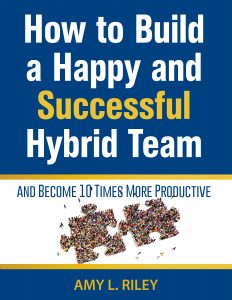
 A Summary of The Courage of a Leader® 4 Pillars
A Summary of The Courage of a Leader® 4 Pillars